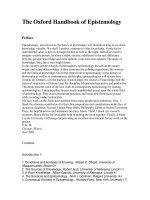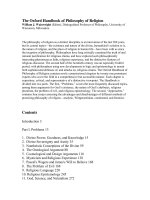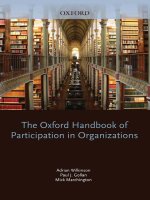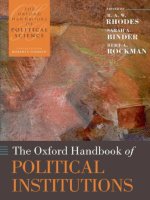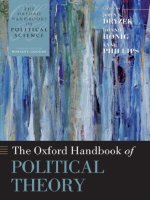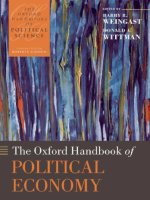the oxford handbook of the economics of
Bạn đang xem bản rút gọn của tài liệu. Xem và tải ngay bản đầy đủ của tài liệu tại đây (4.34 MB, 740 trang )
the oxford handbook of
THE ECONOMICS
OF GAMBLING
CONSULTING EDITORS
Michael Szenberg
Lubin School of Business, Pace University
Lall Ramrattan
University of California, Berkeley Extension
the oxford handbook of
THE ECONOMICS
OF GAMBLING
Edited by
LEIGHTON VAUGHAN WILLIAMS
and
DONALD S. SIEGEL
1
3
Oxford University Press is a department of the University of Oxford.
It furthers the University’s objective of excellence in research, scholarship,
and education by publishing worldwide.
Oxford New York
Auckland Cape Town Dar es Salaam Hong Kong Karachi
Kuala Lumpur Madrid Melbourne Mexico City Nairobi
New Delhi Shanghai Taipei Toronto
With offices in
Argentina Austria Brazil Chile Czech Republic France Greece
Guatemala Hungary Italy Japan Poland Portugal Singapore
South Korea Switzerland Thailand Turkey Ukraine Vietnam
Oxford is a registered trademark of Oxford University Press
in the UK and certain other countries.
Published in the United States of America by
Oxford University Press
198 Madison Avenue, New York, NY 10016
© Oxford University Press 2013
All rights reserved. No part of this publication may be reproduced, stored in a
retrieval system, or transmitted, in any form or by any means, without the prior
permission in writing of Oxford University Press, or as expressly permitted by law,
by license, or under terms agreed with the appropriate reproduction rights organization.
Inquiries concerning reproduction outside the scope of the above should be sent to the Rights
Department, Oxford University Press, at the address above.
You must not circulate this work in any other form
and you must impose this same condition on any acquirer.
Library of Congress Cataloging-in-Publication Data
Vaughan Williams, Leighton.
The Oxford handbook of the economics of gambling/Leighton Vaughan Williams
and Donald S. Siegel.
pages cm. — (Oxford handbooks)
Includes bibliographical references and index.
ISBN 978–0–19–979791–2 (cloth: alk. paper)
1. Gambling. 2. Gambling—Economic aspects. I. Siegel, Donald S., 1959– II. Title.
HV6710.V38 2013
338.4’7795—dc23
2012038792
135798642
Printed in the United States of America
on acid-free paper
Contents
Contributors ix
Introduction xiii
SECTION I CASINOS
1. The Employment Impact of Casino Gambling in the U.S. 3
Gary Anders
2. The Economics of Casino Taxation 18
John E. Anderson
3. The Elasticity of Casino Gambling 37
Mark W. Nichols and Mehmet Serkan Tosun
4. The Economics of Asian Casino Gaming and Gambling 55
Ricardo Chi Sen Siu
5. How does Implementation of a Smoking Ban Affect Gaming? 87
John C. Navin, Timothy S. Sullivan, and Warren D. Richards
6. Overview of the Economic and Social Impacts of Gambling in the
United States 108
Douglas M. Walker
SECTION II SPORTS BETTING
7. The Economics of Online Sports Betting 131
George Diemer and Ryan M. Rodenberg
8. The Football Pools 147
David Forrest and Levi P´erez
9. The Efficiency of Soccer Betting Markets 163
John Goddard
vi contents
10. The Efficiency of Pelota Betting Markets 172
Loreto Llorente, Josemari Aizpurua, and Javier Pu´ertolas
11. The Lure of the Pitcher: How the Baseball Betting Market Is
Influenced by Elite Starting Pitchers 194
Rodney J. Paul, Andrew P. Weinbach, and Brad R. Humphreys
12. Information Efficiency in High-Frequency Betting Markets 210
J. James Reade and John Goddard
SECTION III HORSE RACE BETTING
13. On the Long-Run Sustainability of Tote Betting Markets 235
David Edelman
14. The Economics of Racetrack–Casino (Racino) Gambling 241
Richard Thalheimer
15. The Modern Racing Landscape and the Racetrack Wagering Market:
Components of Demand, Subsidies, and Efficiency 256
Ramon P. DeGennaro and Ann B. Gillette
16. What Explains the Existence of an Exchange Overround? 276
David Marginson
17. Insider Trading in Betting Markets 298
Adi Schnytzer
18. Pricing Decisions and Insider Trading in Fixed-Odds Horse Betting
Markets 316
Adi Schnytzer, Vasiliki Makropoulou, and Martien Lamers
SECTION IV BETTING STRATEGY
19. Betting on Simultaneous Events and Accumulator Gambles 341
Andrew Grant
20. A Primer on the Mathematics of Gambling 370
Robert C. Hannum
21. The Science and Economics of Poker 387
Robert C. Hannum
contents vii
22. The Kelly Criterion with Games of Chance 402
Leonard C. MacLean and William T. Ziemba
23. Exploiting Expert Analysis? Evidence from Event Studies in an
Information-Rich Market Environment 428
Michael A. Smith
SECTION V MOTIVATION, BEHAVIOR
AND DECISION-MAKING IN
BETTING MARKETS
24. Betting Motivation and Behavior 451
Alistair Bruce
25. Motivation in Betting Markets: Speculation, Calculus, or Fun? 474
Les Coleman
26. Evidence of Biased Decision-Making in Betting Markets 487
David McDonald, Ming-Chien Sung, and Johnnie Johnson
27. Behavioral Finance and Point Spread Wagering Markets 518
Greg Durham
SECTION VI PREDICTION MARKETS AND
POLITICAL BETTING
28. A Simple Automated Market Maker for Prediction Markets 543
David Johnstone
29. The Long History of Political Betting Markets: An International
Perspective 560
Paul W. Rhode and Koleman Strumpf
SECTION VII LOTTERIES AND
GAMBLING MACHINES
30. The Efficiency of Lottery Markets 589
David Forrest and O. David Gulley
31. The National Lottery 611
John Lepper and Stephen Creigh-Tyte
viii contents
32. The Benefits and Costs of Slot Machine Gambling 637
Scott Farrow and Chava Carter
33. The Economics of Lotteries: A Survey of the Literature 670
Kent Grote and Victor A. Matheson
34. The Taxation of Gambling Machines: A Theoretical Perspective 692
Leighton Vaughan Williams and David Paton
Name Index 701
General Index 703
Contributors
Josemari Aizpurua is a Professor in the Department of Economics at the Public
University of Navarre in Spain.
Gary Anders is anEmeritus Professor of Economics in the W.P. Carey School of Business
at Arizona State University and Adjunct Professor of Global Economics at Thunderbird
School for Global Management.
John E. Anderson is the Baird Family Professor of Economics at the College of Business
Administration, University of Nebraska–Lincoln (USA).
Alistair Bruce is Professor of Decision and Risk Analysis at Nottingham University
Business School.
Chava Carter is a Research Assistant at UMBC, the University of Maryland, Baltimore
County.
Les Coleman is a Senior Lecturer in the Department of Finance at the University of
Melbourne.
Stephen Creigh-Tyte is Visiting Professor and Research Fellow at Durham Business
School.
George Diemer is Assistant Professor of Business at Chestnut Hill College.
Greg Durham is Assistant Professor of Finance in the College of Business at Montana
State University.
David Edelman is a Senior Lecturer in the School of Business at University College,
Dublin.
Scott Farrow is a Professor in the Department of Economics at UMBC, the University
of Maryland, Baltimore County.
David Forrest is Professor of Economics at the Salford Business School, University of
Salford.
Ramon P. DeGennaro is the CBA Professor in Banking and Finance at the University
of Tennessee.
Ann B. Gillette is a Professor in the Department of Economics, Finance, and
Quantitative Analysis at Kennesaw State University.
x contributors
John Goddard is Professor of Financial Economics at Bangor Business School, Bangor
University.
Andrew Grant is Lecturer in Finance at the University of Sydney Business School.
Kent Grote is Assistant Professor of Economics and Business in the Department of
Economics and Business at Lake Forest College.
O. David Gulley is Professor of Economics at Bentley University.
Robert Hannum is Professor of Risk Analysis and Gaming in the Remain School of
Finance at the University of Denver.
Brad R. Humphreys is Professor of Economics and Chair in the Economics of Gaming
in the Department of Economics at the University of Alberta.
Johnnie Johnson is Professor of Decision and Risk Analysis and Director of the Centre
for Risk Research at the University of Southampton.
David Johnstone is Professor in Finance at the University of Sydney Business School.
Martien Lamers is a doctoral student at the Department of Financial Economics, Ghent
University.
John Lepper is Adjunct Professor, Alfred Deakin Research Institute, Deakin University.
Loreto Llorente is Associate Professor in the Department of Economics at the Public
University of Navarre in Spain.
Leonard MacLean is Herbert S. Lamb Chair in Business Education at Dalhousie
University.
David McDonald is a Research Fellow at the Centre for Risk Research in the School of
Management, University of Southampton.
Vasiliki Makropoulou is Research Associate at Athens University of Economics and
Business.
David Marginson is Head of the Accounting and Finance Section and Professor of
Management Accounting at Cardiff Business School.
Victor Matheson is an Associate Professor in the Department of Economics at the
College of the Holy Cross in Worcester, Massachusetts.
John C. Navin is Professor and Chair of the Department of Economics and Finance at
Southern Illinois University Edwardsville.
Mark W. Nichols is Professor of Economics at the University of Nevada, Reno.
David Paton is Professor of Industrial Economics at Nottingham University Business
School.
contributors xi
Rodney J. Paul is a Professor in Department of Sport Management at the David B. Falk
College of Sport and Human Dynamics at Syracuse University.
Levi Pérez is an Associate Professor in theDepartment of Economics at the University of
Oviedo and a Member of the Research Staff of the Fundación Observatorio Económico
del Deporte.
Javier Puértolas is Associate Professor in the Department of Economics at the Public
University of Navarre in Spain.
J. James Reade is Lecturer in Economics in the Department of Economics at the
University of Birmingham.
Paul Rhode is a Professor in the Department of Economics at the University of
Michigan.
Warren Richards is an instructor in the Department of Economics and Finance at
Southern Illinois University Edwardsville.
Ryan Rodenberg is an Assistant Professor in the Department of Sport Management at
Florida State University.
Adi Schnytzer is Associate Professor of Economics at Bar Ilan University.
Donald S. Siegel is Professor and Dean of the School of Business at the University at
Albany, SUNY.
Ricardo Siu is Associate Professor of Business Economics in the Department of Finance
and Business Economics at the University of Macau.
Michael Smith is a Senior Lecturer in Economics at Leeds Business School.
Koleman Strumpf is Koch Professor of Economics at the University of Kansas School
of Business.
Timothy S. Sullivan is an instructor in the Department of Economics and Finance at
Southern Illinois University Edwardsville.
Ming-Chien Sung is Professor of Risk and Decision Sciences and Director of MSc Risk
Management at the School of Management, University of Southampton.
Richard Thalheimer is President of Thalheimer Research Associates, Inc. in Lexington,
Kentucky.
Mehmet Serkan Tosun is an Associate Professor and Director of Graduate Programs in
the Department of Economics at the University of Nevada, Reno.
Leighton Vaughan Williams is Professor of Economics and Finance and Director
of the Betting Research Unit at Nottingham Business School, Nottingham Trent
University.
xii contributors
Douglas M. Walker is Professor of Economics at the College of Charleston in
Charleston, South Carolina.
Andrew P. Weinbach is the Colonel Lindsey H. Vereen Professor in the Wall College of
Business at Coastal Carolina University.
William Ziemba is Alumni Professor of Financial Modeling and Stochastic Optimiza-
tion, Emeritus at the University of British Columbia. He is also a Visiting Professor at
the Mathematical Institute of the University of Oxford.
INTRODUCTION
In recent years, there has been a substantial rise in interest among academics and
policy makers in the economics of gambling. A concomitant trend in several nations
has been the implementation of major regulatory changes and modifications to the
taxation of gambling markets. Examples include a fundamental change in the United
Kingdom in 2001 from a turnover-based tax on betting operators to a tax based on gross
profits, resulting in the effective abolition of taxation levied directly on bettors (Paton,
Siegel, and Vaughan Williams 2002, 2004), followed in 2005 by extensive reforms to the
gambling sector introduced in the Gambling Act. In the United States, passage of the
Unlawful Internet Gambling Enforcement Act of 2006 had profound implications for
the global online gambling sector. There have also been numerous regulatory changes
to gambling in Europe, Asia, and Australia. These changes, and an increase in attention
paid to revenue generated from this activity, have heightened interest in understanding
the economics of this sector.
Despite growing interest in the economics of gambling, there is no comprehensive
source of pathbreaking research on this very broad topic. The purpose of this handbook
is to fill this gap. We commissioned chapters from leading academics on all aspects of
gambling research. Topics covered include the optimal taxation structure for various
forms of gambling, factors influencing the demand and supply of gambling services,
forecasting of gambling trends, regulation of gambling, wagering on sports, horses,
politics, gambling in casinos and on the Internet, the efficiency of racetrack and sports
betting markets, gambling prevalence and behavior, modeling the demand for gam-
bling services, the economic impact of gambling, substitution and complementarities
among different types of gambling activity, and the relationship between gambling and
other sectors of the economy. These are all important issues, with significant global
implications. Specifically, we divide the handbook into sections on casinos; sports bet-
ting; horse race betting; betting strategy; motivation, behavior, and decision-making in
betting markets; prediction markets and political betting; and lotteries and gambling
machines.
xiv introduction
i Casinos
The first section explores the economic effects of casinos. Gary Anders of Arizona State
University examines the employment impact of casino gambling in the United States in
eight key industries. This is a critical issue due to the recent recession and persistently
high unemployment. Anders reports that expansion of casinos results in employment
increases in arts and entertainment, hotels, and food and beverage industries but leads
to a decline in employment in management and professional services, technology, and
manufacturing (generally high-paying jobs). Thenegative employment effectsof casino
expansion are exacerbated in states with competing gambling venues.
In the next chapter, John Anderson of the University of Nebraska examines how
national governments tax casino gambling, including wagering taxes, admissions taxes,
and fees. He alsoconsiders the effects of taxation on equity and efficiency. An interesting
aspect of Professor Anderson’s analysis is that he highlights major gambling locations,
such as Las Vegas, Macau, and Singapore. Mark Nichols and Mehmet Serkan Tosun of
the University of Nevada, Reno, provide important theoretical and empirical evidence
on price and income elasticities of demand for casino gambling. Ricardo Siu of the
University of Macau analyzes the growth and evolution of Asian casino gambling.
In addition to examining the economic aspects of this activity, he also focuses on
the significance of the unique features of Asian culture and the related institutional
structure of gaming industry performance. Finally, Professor Siu assesses the social
benefits and costs of casino gaming in Asia.
John Navin, Timothy Sullivan, and Warren Richards of Southern Illinois University
Edwardsville review the literature on gaming and the restriction of smoking. They
then present an empirical analysis of the effects of a smoking ban on the riverboat
casino market in the Illinois portion of the St. Louis Metropolitan area. The section on
casinos concludes with a chapter by Douglas Walker of the College of Charleston, who
summarizes empirical research on the economic and social impacts of gambling. Issues
considered in this chapter include the effects of casino gambling on economic growth,
relationships among gambling industries and the implications of these relationships
for net government tax revenue, the social costs of gambling, casinos and crime, casinos
and political corruption, and problems with applying cost-benefit analysis to gambling.
ii Sports Betting
The second section begins with a chapter by George Diemer of Chestnut Hill College
and Ryan Rodenberg of Florida State University on a growing sector of the gambling
industry: online sports betting. Diemer and Rodenberg consider this sector from a law
and economics perspective and compare the efficiency of online/offshore sports books
relative to conventional sports books in Las Vegas and London.
introduction xv
David Forrest of the University of Salford and Levi Pérez of the University of Oviedo
examine football pools, defined as any pari-mutuel wagering concerning the outcomes,
or any other aspects, of football (soccer) matches. These are long odds, high-prize
games where a share of the jackpot is linked to football results. Salford and Pérez assert
that this type of wagering closely resembles lotto, where the difference between the
two types of games is that one depends on football results while the other is based on
numbers drawn randomly. They review the literature on football pools, focusing on
the United Kingdom and Spain.
In the next chapter John Goddard of Bangor University examines the efficiency of
soccer betting markets. Specifically he evaluates whether certain types of forecasting
models can be used to develop profitable fixed-odds betting strategies. A key find-
ing is that inefficiencies in the market have been largely eliminated by the increased
sophistication of contemporary sports betting markets, greatly enhanced by advances
in information technology.
Loreto Llorente, Jose Maria Aizpurua, and Javier Puértolas of the University of
Navarra examine the efficiency of a special type of betting market: wagering on pelota
matches. These are games with two mutually exclusive and exhaustive outcomes, where
wagers are made among viewers via a middleman who receives 16 percent of the prize.
Based on field data, the authors analyze three different concepts of market efficiency
widely utilized in the literature and also provide some insights for future research on
hedging strategies in these markets.
Rodney Paul of Syracuse University, Andrew Weinbach of Coastal Carolina Univer-
sity, and Brad Humphreys of the University of Alberta study the baseballbetting market.
The authors ask a very specific research question: How do elite starting pitchers affect
gambling behavior and volume? Using comprehensive data, they report that games
involving an elite pitcher attract more bettors, especially on the “under” wager. J. James
Reade of the University of Birmingham and John Goddard of Bangor University ana-
lyze information efficiency in high-frequency betting markets. Their analysis is based
on“betting exchanges,” which enable traders to either buy or sell bets on many sporting
events. Such continuously operating online betting markets have ensured the transition
of the use of high-frequency data from the financial setting into the betting market con-
text. The authors review recent academic research on the topic of information efficiency
in high-frequency, in-play betting markets for football (soccer).
iii Horse race Betting
David Edelman of University College Dublin examines the implications of the alleged
“takeover” of tote (totalizator) betting markets by “sophisticated” gamblers. Based on
a mathematical analysis, he concludes that their activity could not in itself seriously or
irreparably damage pari-mutuel markets. Richard Thalheimer of Thalheimer Research
xvi introduction
Associates examines an important trend: the rise of casino-style gambling at pari-
mutuel racetracks. Specifically he analyzes the impact of “racino” betting on pari-
mutuel racing as well as its effects on state lotteries and casino gaming.
Ramon DeGennaro of the University of Tennessee and Ann Gillette of Kennesaw
State University provide a comprehensive economic analysis of racetrack betting. The
authors examine the effects of technological change on this industry, the growth and
evolution of betting options,and the efficiency of the bettingmarket. They also consider
the antecedents and consequences of subsidies for this sector, which many view as a
declining industry. David Marginson of Cardiff Business School examines starting
price–based overrounds on Betfair, the leading person-to-person Internet betting site.
His empirical analysis is based on 2,184 horse races that took place in the United
Kingdom between 2008 and 2010. He reports a positive relationship between grade
of race and Betfair overround (the higher the grade, the higher the overround). His
results imply that microstructure analysis of order-driven betting markets, such as
Betfair, constitutes a fruitful area of research for those interested in understanding
market efficiency.
Adi Schnyzter of Bar-Ilan University examines the incidence of insider trading in the
market for horse and greyhound racing. He analyzes whether the presence of betting
insiders at the track implies that their presence is easily detected. It is shown that this
is a function of the microstructure of the particular betting market. In some markets
the impact of insider trading is readily measured, while in others it has hitherto proven
virtually impossible to detect. The different microstructures of betting markets and the
implications for insider trading and its measurement are considered.
In the following chapter, Schnytzer, Vasiliki Makropoulou of Utrecht University, and
Martien Lamers of Ghent University analyze pricing decisions and insider trading in
fixed-odds horse racing. This chapter conceptualizes fixed-odds horse betting markets
as implicit call option markets. The decision-making process of a bookmakeris modeled
as a decision-maker who sets prices under uncertainty. The authors show that when
a bookmaker adopts this pricing process built on implicit options, the returns will
exhibit a favorite-longshot bias. By performing Monte Carlo simulations, option values
are generated and a measurement is made of the degree of insider trading.
iv Betting Strategy
The section on betting strategy begins with a chapter by Andrew Grant of the Univer-
sity of Sydney, who examines the predictability of sports betting markets. Specifically
he analyzes wagering on simultaneous events and “accumulator gambles.” These are
situations in which multiple games occur simultaneously. In this case the gambler must
consider the problem of allocating capital across different games or events, similar to
the situation when an investor allocates capital to different stocks in a portfolio. The
introduction xvii
author explores the use of accumulator bets (parlays) as part of a portfolio betting
strategy.
Robert Hannum of the University of Denver presents a primer on the mathematics of
gambling. He demonstrates how the mathematics behind the games generates revenues
and drives the economics of gambling. In the following chapter, Hannum describes the
science and economics of poker, also from a mathematical standpoint. He also discusses
the history of this popular table game. Hannum asserts that poker is unique among
gambling activities for two reasons. First, it is not house-banked. Second, there is a
considerable amount of skill involved in this game, which is not the case for other
casino and lottery games.
Leonard MacLean of Dalhousie University and William Ziemba of the University of
British Columbia describe an interesting betting strategy known as the Kelly strategy,
where the expected logarithm of final wealth is maximized. The authors consider
the advantages and disadvantages of this strategy, with reference to its application in
blackjack, horse racing, lotto, and anomalies in the index futures markets. They also
discuss the use of Kelly-type strategies by what they term “great investors.”
The section on betting strategy concludes with a chapter by Michael Smith of Leeds
Metropolitan University, who explores the performance of “experts,” or media fore-
casters, in selecting winners. He also provides a more comprehensive examination of
the degree of information efficiency with respect to these events. His empirical analysis
considers whether there are any betting strategies based on these “expert”picks that can
systematically beat the market.
v Motivation, Behavior, and
Decision-Making in Betting Markets
Alistair Bruce of the University of Nottingham examines individual motivations for bet-
ting, synthesizing perspectives from economics, psychology, and sociology. His results
have important implications for policy makers designing legal and regulatory regimes
for betting as well as for those interested in treating the negative effects of “excessive”
exposure to betting. The next chapter, by Les Coleman of the University of Melbourne,
examines a variety of characteristics of betting markets. He focuses on comparing
betting markets to financial markets and then assesses the motivations for gambling.
In a similar vein David McDonald, Johnnie Johnson, and Ming-Chien Sung of
the University of Southampton present evidence of biased decision-making in betting
markets. An interesting aspect of their research is that they demonstrate how systematic
biases that were first identified in the laboratory are reflected in real-world gambling
behavior. Greg Durham of Montana State University examines sports betting, and
specifically point spread wagering, through the lens of “behavioral finance,” which
draws heavily from psychology.
xviii introduction
vi Prediction Markets and
Political Betting
David Johnstone of the University of Sydney examines the question of the predictability
of sports betting markets based on a simple automated “market maker” for prediction
markets. He notes that there is great potential for the use of automated “robot” market
makers in prediction markets and market simulation games, based on research in
experimental economics and behavioral finance. He outlines the benefits of adopting
such an approach in terms of two key advantages: (1) the model is easy to derive and (2)
the opening security price can be set arbitrarily between zero and one, so as to match
the market maker’s prior beliefs.
The next chapter, by Paul Rhode of the University of Michigan and Koleman Strumpf
of the University of Kansas, describes the long history of political betting markets.
Contrary to popular wisdom, political futures markets are not a recent invention. The
authors trace the operation of political futures markets back to sixteenth-century Italy,
eighteenth-century Britain and Ireland, nineteenth-century Canada, and twentieth-
century Australia and Singapore. They also note that election wagering was quite
popular in the United States in the pre-1860 period but during the post-1860 period
became increasingly concentrated in the organized futures markets in New York City.
vii Lotteries and Gambling Machines
David Forrest of the University of Salford and O. David Gulley of Bentley University
examine the efficiency of lottery markets. The authors conclude that lotto players act as
if they understand the “rules of the game” and appropriately use relevant information
about the games. Exceptions to efficiency are found, but these “inefficiencies” cannot
be easily exploited by bettors.
John Lepper of Deakin University and Stephen Creigh-Tyte of Durham Business
School provide an historical analysis of the U.K. National Lottery. Although the first
National Lottery draw of the modern era occurred in November 1994, state-sponsored
lotteries had been common since the reign of Queen Elizabeth I. The authors describe
the development of the National Lottery and consider the introduction, nature, and
performance of the modern Lottery while also describing the economics of the National
Lottery.
Scott Farrow and Chava Carter of the University of Maryland, Baltimore County,
assess the costs and benefits of slot machine gambling. This chapter begins by defining
the slot machine segment of the gambling industry and then reviews the economics of
these machines based on benefit-cost analysis. They also review illustrative empirical
studies and provide suggestions for additional research.
introduction xix
Kent Grote of Lake Forest College and Victor Matheson of the College of the Holy
Cross survey the literature on the economics of lotteries in terms of two central themes.
The first section examines the microeconomic aspects of lotteries, including consumer
decision-making under uncertainty, price and income elasticities of demand for lottery
tickets, cross-price elasticities of lottery tickets to each other and to other gambling
products, consumer rationality and gambling, and the efficiency of lottery markets.
The second section covers topics related to public finance and public choice, including
the revenue potential of lotteries, the tax efficiency and dead-weight loss of lottery
games, the horizontal and vertical equity of lotteries, earmarking and the fungibility of
lottery revenues, and individual state decisions to participate in public lotteries.
Leighton Vaughan Williams of Nottingham Trent University and David Paton of
the University of Nottingham consider the taxation of gambling machines. Although
there has been considerable research on the economic impact of gambling on regional
economies in the United States and the United Kingdom, relatively little research has
focused on the optimal taxation of gambling machines within these facilities. The
authors seek to fill this gap by examining the theoretical arguments for taxing gambling
machines by means of a levy on machine takings rather than by means of a licence fee
levied per machine. Recent tax debates in the United Kingdom provide an ideal context
for such a discussion.
References
Paton, David, Donald S. Siegel, and Leighton Vaughan Williams. 2002. A policy response
to the e-commerce revolution: The case of betting taxation in the UK. Economic Journal
112(480): F296–F314.
——. 2004. Taxation and the demand for gambling: New evidence from the United Kingdom.
National Tax Journal 57(4):847–861.
This page intentionally left blank
section i
CASINOS
This page intentionally left blank
chapter 1
THE EMPLOYMENT IMPACT
OF CASINO GAMBLING IN THE U.S.
gary anders
The Growth of Gambling in
the United States
Over the past twenty years, gambling has become a growth industry in the United
States, the United Kingdom, Canada, Australia, Macau (Macao), and other nations.
1
Once restricted to Nevada and, later, Atlantic City, casinos now operate in 33 U.S. states.
Since Congress passed the Indian Gaming Regulatory Act (IGRA) in 1988, tribes in 28
states have established casinos, and others are seeking federal recognition so that they
can do the same. According to the National Indian Gaming Commission, 236 Indian
tribes are currently operating casinos.
2
In 2010, Indian casinos earned approximately
$26.5 billion (National Indian Gaming Commission 2011). California alone has 56
tribal casinos, making it one of the most lucrative gambling markets in the world.
Starting in 1989 with Iowa, states began to legalize land-based riverboat casinos, horse
and dog racetrack casinos (racinos), and urban casinos.
3
Altogether these non-Indian
commercial gambling casinos earned over $34.6 billion in gross gambling revenues in
2011 (American Gaming Association 2011). Including those operated by Indian tribes
and regulated by the states, casinos generated over $61 billion in annual revenues.
Over a decade ago, the National Gambling Impact Study Commission (NGISC) was
established to investigate various issues regarding the legalization of gambling. After
sponsoring several major studies and conducting hearings in different cities across
the country, the NGISC issued a final report that called for a moratorium on new
gambling venues (NGISC 1999). Despite this recommendation, new casinos continue
to be established, with urban land-based casinos and Indian casinos being the most
prevalent. The rapid growth of commercial gambling has been striking not only in
4 casinos
the United States but also worldwide. The unprecedented growth of government-
sanctioned gambling raises a number of policy issues related to the social and economic
impacts of gambling. The purpose of this study is to examine how the introduction
of commercial gambling casinos impacts a state’s economy by focusing on changes in
industry employment.
This chapter is divided into four parts. The first provides an overview of the literature
on the economic and social impacts of commercial gambling. This is followed by a set of
hypotheses that are usedtoexamine the effects of casinogambling on state employment.
Next, a regression analysis of the relationship between changes in industry employment
and gambling is presented. The conclusion summarizes the findings and discusses the
limitations of the study and future research directions.
Literature Review
This section summarizes some of the most relevant research on the economic and
social impact of casinos on local communities. A useful starting point is Rose (2001).
Based on a survey of more than 100 published studies, it concluded that, as a general
rule, a new casino provides positive economic benefits to its host economy. Among
these benefits are direct and indirect employment from the construction of the casino,
taxes collected by the state, the capture of gambling revenues from residents who
would otherwise gamble in out-of-state casinos, the increase in consumer utility from
additional recreational choices, and employment from casino jobs. Rose also mentions
such social costs as increased gambling addictions, congestion, and profits going to
outside interests. He claims that most of the economic impact studies he reviewed
suffer from a number of critical flaws, major omissions, or biased assumptions.
Various gambling interests have sponsored numerous studies to support the adop-
tion of casinos. Representative of this type of work is the Arthur Andersen study
conducted for the American Gaming Association (AGA). Without mentioning any
negative impacts, this study lauds the economic benefits of casinos, asserting that “the
introduction of casinos leads to growth in almost all other areas: retail sales, commercial
and housing construction, restaurants, etc.” (Arthur Andersen 1997, 45) and claiming
that casinos are responsible for increased taxes, employment growth, and reductions in
the number of families on welfare. Similarly, a recent AGA-funded study by the Brattle
Group (2011) provides analysis supporting the positive impact of casinos and includes
direct, indirect, and induced multiplier effects of casinos. What is interesting is that
this study expands the scope of casino operations to include hotels, food and beverage
services, and other business lines.
William R. Eadington (1998), a leading scholar in the field, includes tourism devel-
opment, economic revitalization, tax revenue, jobs, new investment, and employment
opportunities for minorities as expected benefits from casinos. He argues that destina-
tion resort casinos are the strongest in job creation, due to the fact that these casinos
